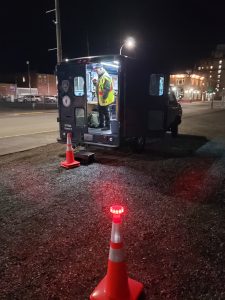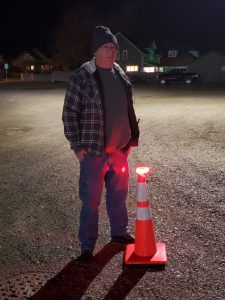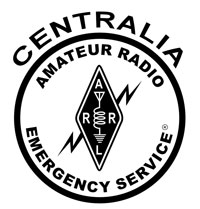
It is dark tonight and cold. The stars sparkle in the late winter sky and the temperatures hover around 23 degrees. The snow is finally gone and it is a great evening to practice nighttime landing zone setups so out into the night we go. This evening we’re not using one of the designated team LZ’s. Nope, we found a flat, gravel lot surrounded with 360 degrees of LZ issues. The lot is just barely big enough for a 100 x 100 foot LZ. To the south is an eight story apartment building. To the east is a four story church. To the west is a three story structure and there are light poles and electric wires aplenty.
Once our ARES Communications van is set up on the east side of the potential landing zone, Skip, K1HEK, brings up all the communications systems and makes sure they are operating as they should. As part of tonight’s exercise, we do a communications test with the Lewis County Central Dispatch on the fire department’s REDNET frequency – the channel used for normal medical helicopter comms in our area. All is well and we have a strong signal into dispatch.
Meanwhile, four other other team members are busy setting out the 100 x 100 foot landing zone with an orange traffic cone at each corner. Tonight, the winds are negligible so no cones showing wind direction are put out. Once the cones are in place FRED (flashing roadside emergency discs) lights are placed atop each corner traffic cone. Don, KI7ZNG, is busy determining the GPS coordinates for our temporary landing zone. Finally, each member of the landing zone team works together to prepare a pilot briefing. The briefing must include the GPS coordinates, warnings about overhead wires, light standards, flag poles and of course those multi-story buildings. The pilot will need a physical description (downtown parking lot – flat with gravel surface) with the LZ set out using orange traffic cones with flashing red lights on them. Surface winds are negligible but we will keep an eye on the flag atop a nearby building just in case. Even though our medivac helicopter is only 15 minutes away, the team has managed to set up the LZ and prepare a pilot briefing before the sound of an approaching helicopter would be heard. Maybe it is the cold but the team worked well

together with only a few disagreements about directions.
With no real helicopter coming tonight and with the temperature dropping, we picked up and repacked everything and headed back the the Emergency Operations Center where it was warm to debrief and go over our pilot briefing notes. The team finishes the evening’s training with a discussion about safety issues. An interesting question comes up. Could one team member, with one of our communications vans, set up and run the entire landing zone? We decide it could be done if manpower levels required it but communications with the pilot would need to be done outside where the landing zone officer could have a 360 degree view. This would also require the use of the van’s HT using 5 watts instead of the normal 50 watt radios permanently attached inside the van. As long as we had an obstruction free signal to the helicopter, the job could be done safely.
Why do we practice setting up a helicopter landing zone in the dark and in the cold? Because bad things happen and if the fire department or the police department needed a landing zone set up in a hurry, there simply would not be enough time to ask questions. The job would need to be done quickly and safely in under 15 minutes. Besides, it beats sitting around watching old movies on the TV. Thanks to the team members willing to brave the cold last evening. In two hours, you have made our community a safer place to work and live.

